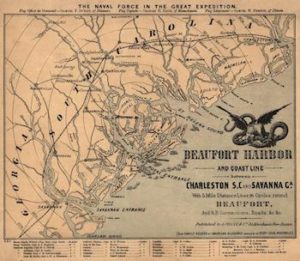
*The Port Royal Experiment began on this date in 1861. This educational program involved former slaves successfully working on the land abandoned by white-American planters.
It started during the American Civil War after the Union captured the Sea Islands off the coast of South Carolina and their main harbor, Port Royal. The whites fled, leaving behind 10,000 Black slaves. Several private Northern charity organizations stepped in to help the former slaves become self-sufficient.
This model for Reconstruction allowed Blacks to determine their ability to work the land efficiently and live independently of white control. They assigned themselves daily tasks for cotton growing and spent extra time cultivating their crops, fishing, and hunting. By selling their surplus crops, the locals acquired small amounts of property. The Northerners who arrived as teachers were Mary Lambert Allen and her husband, William Francis Allen. Detailed descriptions of their daily life are provided in his diaries, which have been transcribed. Admiration for the hard work ethic of the former slaves is mentioned, as well as the urgent need for a basic education of which they had been deprived.
Allen also took notes on the language, songs, and music he heard, which he later published. In February 1862, a report was made to the Treasury Dept. which gives an indication of the territory held in the Port Royal Experiment: Or about two hundred in all, the report also stated from ---E. L. Pierce, The Negroes at Port Royal: Report of E. L. Pierce, Government Agent, to the Hon. Salmon P. Chase, Secretary of the Treasury, 1862. “There are several other islands thus protected, without plantations, as Otter, Pritchard, Fripp, Hunting, and Phillips. Lemon and Daw have not been explored by the agents engaged in collecting cotton. The populous island of North Edisto, lying in the direction of Charleston and giving the name to the finest cotton, is still visited by the rebels. A part near Botany Bay Island is commanded by the guns of one of our war vessels, under which a colony of one thousand negroes sought protection, where they have been temporarily subsisted from its stores. The number has within a few days been stated to have increased to 2300.”
In the summer of 1862, Union troops protecting coastal colonies began to withdraw to reinforce Union General George B. McClellan, who was engaged in the Peninsula Campaign, a series of battles between March and July. Many of the colonies were consolidated. One example was the migration of camps at Edisto Island to St. Helena Island.